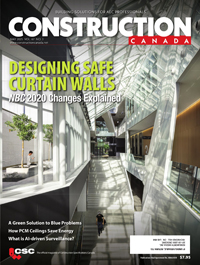Creating better masonry with material compatibility
The specified slider id does not exist.
Brick ties and stone anchors
Various ties are available for cavity walls to link the outer wythe to the structural wall. The most effective are three-part systems consisting of a barrel engineered specifically for the cavity width. These have a screw designed to penetrate the specified structural backup wall such as CMUs, or steel or wood studs with sheathing. A plastic clip then acts as both a thermal break and a dissimilar metals break and connects to the wire tie, which can be hot-dip galvanized or stainless steel (Figure 1).
The Masonry Society (TMS) 402, Building Code Requirements for Masonry Structures requires Type 304 or 316 stainless steel, or hot-dip galvanized after fabrication (HDGAF) for exterior wall anchors. It is extremely important to specify HDGAF instead of ‘galvanized’ for exterior applications. If ‘galvanized’ or even ‘hot-dip galvanized’ is specified, the contractor may use ‘mill’ galvanized ties, which are incompatible with exterior applications. Mill galvanized ties are cut from steel that has been galvanized in rolls at the mill before the anchors are cut—meaning they have uncoated ends and must only be used for interior applications. Hot-dip galvanized after fabrication ties, as the name implies, are galvanized after fabrication and have no exposed steel. Additionally, mill galvanized ties are incompatible with masonry in interior areas exposed to continuous humidity levels of 75 per cent or higher, such as indoor pools or locker rooms. In these conditions, HDGAF or stainless should be used.
Stone anchors must be custom manufactured, so contractors and designers must allow adequate time to design and manufacture the anchors before they are needed on the job site. They are typically made from stainless steel to avoid galvanic responses between ties and minerals in the natural stone. Cast stone, which is actually concrete, does not require stainless steel, but given the small cost difference relative to the cost of anchor failure, stainless is the better choice because it eliminates compatibility problems.
Wire reinforcement
Ladder- or truss-type horizontal joint reinforcement is used in CMU structural walls to provide lateral stability. In the 1960s, horizontal wire reinforcement became the norm in CMU walls, and in the 1990s, vertical rebar reinforcement was added to standard recommendations throughout North America.
Truss-type reinforcement may be incompatible with CMU walls with full or partially grouted cells—not because of a materials issue, but because the cross-wires can interfere with vertical rebar placement and grout flow. Minimum wire thickness is 9 gauge or 3.7 mm (0.1483 in.) and mortar bed thickness must be at least twice the thickness of the embedded wire (Figure 2).
Stainless steel, HDGAF, or epoxy-coated wire should be specified to avoid in-wall corrosion. Ladder-type wire reinforcement may be formed in a way that spans the cavity, either with solid wire or with eyes designed for use with separate pintles, so it acts as both CMU reinforcement and a brick tie.
While these types of reinforcement configurations have been accepted for decades and are not incompatible with standard masonry materials, it is highly recommended ladder-type wire reinforcement not extending past the exterior of the CMU backup wall be used in combination with the aforementioned separate brick anchors. This is because they allow greater movement in the wall and provide a very effective thermal break (Figure 3).
Air- and watertight washers
For maximum energy efficiency, 50-mm (2-in.) diameter plastic washers should be used with the brick-tie barrel anchors when they are penetrating RI in the cavity to help seal out air and moisture while permanently attaching the insulation. Some proprietary washers also have pre-spotting prongs that embed into the insulation for easy on-the-wall veneer anchor assembly and attachment through the RI and into the substrate (Figure 4). Additionally, other manufacturers of washers, ties, and fasteners have tested their products to be compatible.
They are components in a complete wall system in which all materials—including water-resistive barriers (WRB), mortar-dropping collector, wall flashing, pre-formed corners and end dams, and weep vents—proven compatible and have passed National Fire Protection Association (NFPA) 285, Standard Fire Test Method for Evaluation of Fire Propagation Characteristics of Exterior Non-loadbearing Wall Assemblies Containing Combustible Components. It is important for designers to understand that individual components cannot be NFPA 285 tested by themselves. They can only be tested as part of a wall system.
Wall flashings, corners, and end dams
Wall flashings are placed at the bottom of the wall and should run for at least 305 mm (12 in.) up the structural wall. Some designers have chosen to omit a metal drip edge and end the flashing at the end of the brick ledge so the edge of the flashing is visible. Unfortunately, this practice creates the possibility of flashing ‘drool’ caused by ultraviolet (UV) exposure—a case of incompatibility between a building material and the environment (Figure 5). Attaching the flashing to a metal drip edge is a better choice, because it eliminates the drool, and helps direct water away from the masonry face. Drip edges are available in stainless steel, copper, and various colours of coated steel, which can blend with the brick colour.
There are several flashing membranes available, including thermoplastic vinyl, rubberized asphalt, thermoplastic polyolefin (TPO), copper/polypropylene composite, and ethylene propylene diene monomer (EPDM). Incompatibility between the flashing, drip edge, and sealant will almost certainly result in a poor seal and the opportunity for water to work under the flashing and back to the structural wall. For example, a modified polyether sealant may be used with most flashing membranes, but is incompatible with both TPO and copper/polypropylene blend composite membranes. Butyl sealants will bond with all common flashing membranes, preformed corner boots and end dams, and also provide high flexibility without adhesive or cohesive failure.
The use of a termination (term) bar is also recommended, even on membranes with a peel-and-stick adhesive backing. Polyvinyl chloride (PVC) and stainless term bars are available, with the former perfectly adequate for all but the most corrosive environments. The term bar physically fastens the top edge of the wall flashing to the structural wall and must be attached with screws. Nails or staples will not provide adequate fastening.
The top of the term bar must be sealed with a sealant, liquid-applied WRB, or tape in order to direct water that runs down the WRB onto the flashing and prevent it from getting behind the term bar (Figure 6). If the bar is attached to a structural wall with a liquid-applied WRB, it will be installed after the WRB has been applied and on top of it—meaning any form of sealant applied to the top of the term bar will be in contact with the WRB. It is important to check with the WRB and sealant manufacturers to ensure the two products have been tested for compatibility.
If the term bar is attached to a wall using a sheet-applied WRB, the barrier must lap at least 152 mm (6 in.) over the top of the term bar. If it is attached over one of the new RI/WRB combination products, the fastening screws must be long enough to penetrate at least 19 mm (¾ in.) into the studs or CMU. These combination products frequently use tape to seal the joints between the RI sheets and the top of the term bar. One should confirm installers use tape from the same manufacturer as the RI/WRB product, and check with the flashing and RI/WRB manufacturer to ensure the tape will aggressively adhere to the term bar and the flashing. It is also important the RI/WRB manufacturer has a detail for sealing around the term bar fasteners. Incompatibility among these materials can result in leaks behind the flashing.
Water infiltration and the resulting damage is most likely to occur at corners and above wall openings due to improperly installed or missing flashing components. If corners are formed in the field by the ‘origami’ method, where the installer hand-fabricates corners and end dams out of pieces of the flashing membrane, variability in the skill of the installer and adverse weather conditions can compromise quality. The lack of end dams above windows allows water to run down the space between the jam and the masonry. Whenever cracks form in a masonry veneer at the corners of the window sills, the most likely culprit is leaking or non-existent end dams at the window heads. The recommended practice for the best seal is the installation of one-piece corner boots and end dams, which eliminates the unreliability of the ‘origami’ installation. One should confirm compatibility between the flashing membrane, boots, dams, and sealants by contacting the manufacturers.
Some manufacturers provide a total, panelized flashing system that includes the flashing membrane factory-bonded to a mortar dropping collector, weep tabs, metal drip edge, and term bar. Screws for the term bar with neoprene washers creating air- and watertight seals around the screws may also be included. Such proprietary systems can come with pre-formed corner boots, end dams, and sealants guaranteed to be compatible with all other components (Figure 7).
Another masonry cavity wall system, created by five different building products manufacturers, has been tested and proven for complete compatibility among all the components, including WRB, RI, flashing, mortar dropping collectors, fasteners, sealants, brick anchors, and weep vents (Figure 8). This system has also passed tests such as NFPA 285, and ASTM E2357, Standard Test Method for Determining Air Leakage of Air Barrier Assemblies and E331 Standard Test Method for Water Penetration of Exterior Windows, Skylights, Doors, and Curtain Walls by Uniform Static Air Pressure Difference.
Conclusion
With all the components available to the designer and builder in today’s masonry cavity walls, it can be time-consuming to verify all selected components are compatible with one another and with the environment. However, this is imperative to ensure material performance and functionality. Fortunately, manufacturers are now offering tested wall systems in which multiple components have been proven compatible, making the designer’s job faster and less risky. (The Masonry Advisory Council’s (MAC’s) Design Guide for Taller Cavity Walls, by Paul Curtis et al., was referenced for this article. To read the piece, click here).
 Art Fox is the director of marketing for Mortar Net Solutions, a manufacturer of moisture management products for masonry walls, including cavity, single-wythe concrete masonry unit (CMU), and adhered masonry walls. He has been working with Mortar Net Solutions for more than 23 years. Fox can be reached at afox@mortarnet.com.
Art Fox is the director of marketing for Mortar Net Solutions, a manufacturer of moisture management products for masonry walls, including cavity, single-wythe concrete masonry unit (CMU), and adhered masonry walls. He has been working with Mortar Net Solutions for more than 23 years. Fox can be reached at afox@mortarnet.com.







